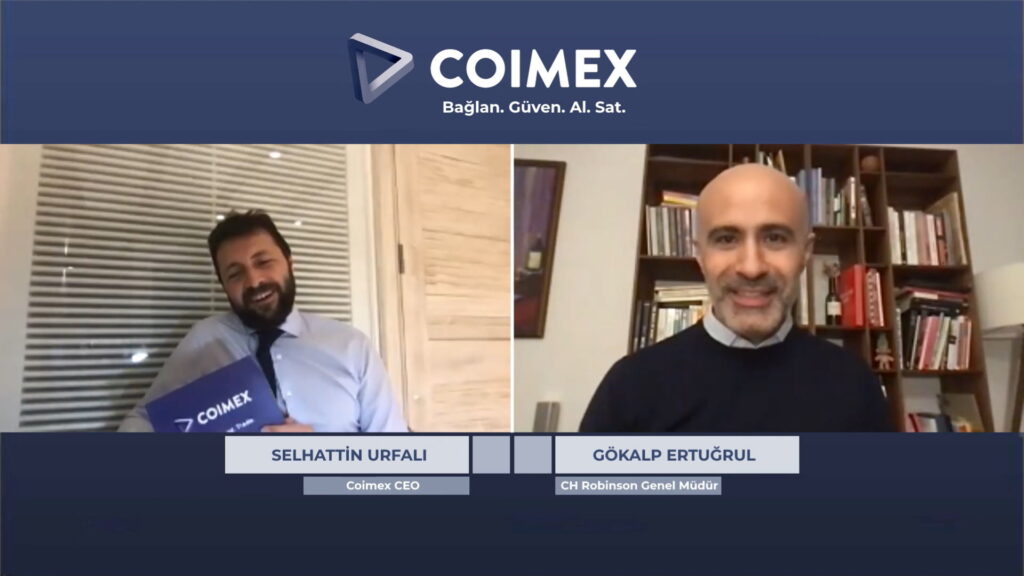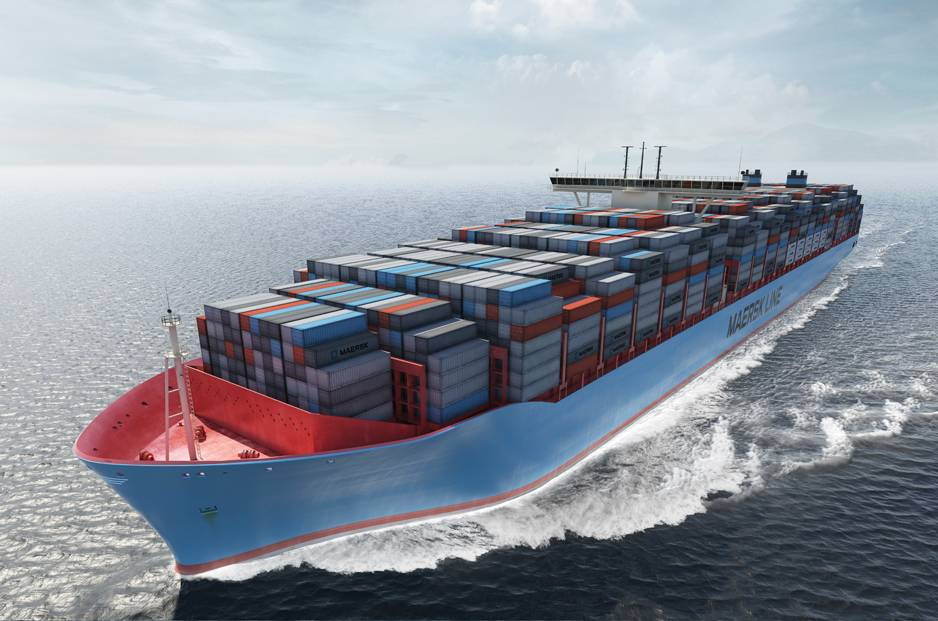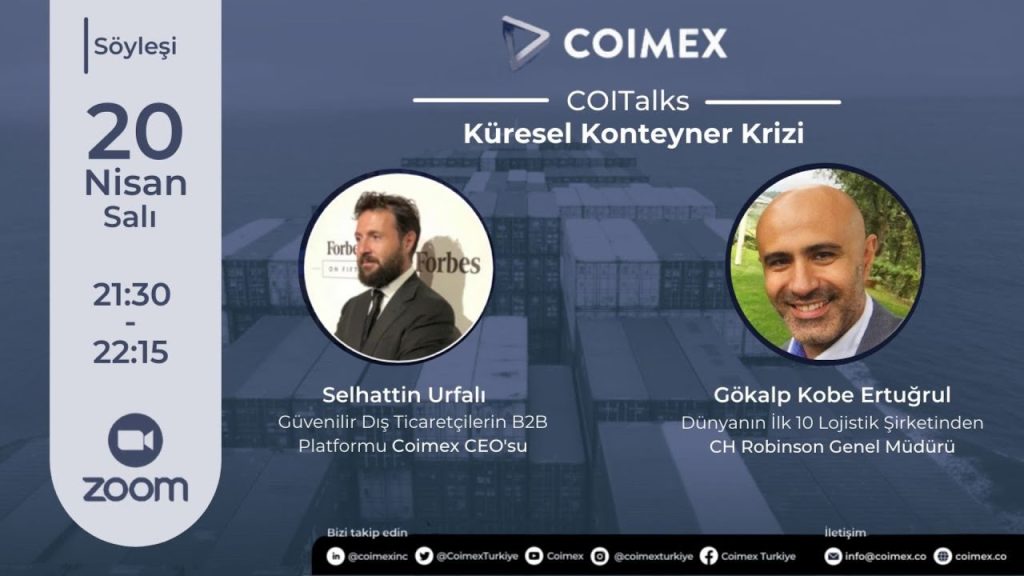
Selhattin Urfali, CEO of Coimex, made an interview with Gokalp Kobe Ertugrul, General Manager of CH Robinson, one of the top 10 logistics companies with a turnover of 16 billion dollars, on the evening of Tuesday, April 20, on the Global Container Crisis.
Coimex contributes to the foreign trade sector and tries to find solutions to the problems in the sector by bringing the important issues of foreign trade to online platforms with the online foreign trade webinars and interviews it organizes.
In a live interview that lasted about an hour on Zoom, CH Robinson General Manager Gökalp Kobe Ertuğrul asked, “What is the situation in the global container crisis now?” “What will be the situation in 2022?” In addition to the topics of “How can this crisis be overcome”, he made 6 important suggestions for overcoming logistical crises easily.
Coimex, which had its first interview with the topic of “5 Strategies in East African Customs Legislation”, continues to organize training, meetings, events, and conversations to benefit foreign traders with COITalks conversations.
Selhattin Urfali: “Our aim in these conversations is to make suggestions to our traders that they can create opportunities”
Today we will talk about a trending topic. As Coimex, we try to keep the pulse of the foreign trade world. Our aim in these conversations is to make suggestions to our traders, especially in the world of foreign trade, where they can create opportunities and bring solutions to their problems.
Selhattin Urfali (SU): What is this global container crisis and why did it happen? This subject has been covered a lot in the press, but can you briefly summarize it for us?
Gökalp Ertuğrul (GE): If we explain in one sentence what the container crisis is; the containers are not where they should be, they are in different warehouses or at different ports. The situation where the containers in demand cannot be reached due to the fact that the containers that should be mainly in Asia are left in various parts of the world, especially in North America.
How The Container Crisis Arose?
With the pandemic, the container supply could not be put on the market. As most of us know, China is the center country here. The country through which many containers circulate. The onset of the pandemic in China and the closure of China reduced the container circulation in the market and then started the container crisis in 2020. Increasing demand in the United States before Christmas has caused containers to shift predominantly to North America. It was the differences between these two continents that disturbed the supply-demand balance. Containers going to America could not circulate again with the effect of the pandemic in the USA. A crowd has formed. This, in turn, affected supply-demand and prices all over the world with the butterfly effect. It took 20-25 days for a ship to berth and transport in the USA. This is quite a long time. In this case, it took more than the average time for the container to return to the port. In summary, the supply-demand imbalances caused by the pandemic created this situation. We are experiencing a crisis caused by the containers not reaching where they should be.
Why Do We Use The Word “Crisis”?
We can underline why we use the word crisis. Except for the world wars, there has never been a problem of finding equipment at this rate in the globalizing economy. 85-86% of world trade is done by sea. Therefore, containers are an important part of this. No container means there really is a crisis. This situation was also reflected in the freight prices.
SU: What is the current situation? And what are we waiting for? Can you briefly summarize that? We got out of here and I wonder if you still keep the prices at the same level? There is no crisis, do you reflect it to us or is the crisis still going on? Can you tell me what the situation really is?
GE: Actually, I guess we look at it a little bit… But to give an insight, objectively, the lack of capacity continues. The fact that the containers accumulated in North America did not return to Asia, that the containers that were supposed to come from Asia to Europe did not come… We can make a numerical comparison. In November and December 2020, this negative picture only rose. The increase in freights that should normally come from Asia to Europe increased by 24-25%. Again, the freight increase in shipments from Asia to the Mediterranean Region (to Turkey, Greece, Italy, and Spain) reached 30%.
If we look at the back, it actually came down to 4-5 consortiums in the world that manage containers. What does this mean? It’s a kind of monopoly. While not a complete monopoly, it means that these companies manage and dominate containers around the world. From one point of view, the day was born for these companies. They are doing their best to keep the prices up but is there any concrete proof of this and can we put it up? It is really hard! Because the word comes back to supply and demand.
From another point of view, the trade war between America and China; turned into container wars and logistics wars. For example, Chinese containers must be returned to Asia as soon as possible so that they can be loaded with high freight rates, but America says, ‘We will never send empty containers! If the containers are necessary, they will wait at the port, if necessary, we will not unload the ships. Here, states are said to be involved, but I guess we have to somehow rely on the free market and the ‘invisible hand’ principle. At least that’s my opinion. The market will stabilize sooner or later.
What Is Happening In The Background In Practice?
There are the highest deviations in the history of the planned voyages in the scheduled ship departure and arrival times. There are deviations of 45-50%. What side effect does this have? Reservation times have been shortened due to very high demands. It’s kind of like being in the hands of the trap. Whoever can catch it and make the reservation gets that container. This, of course, puts serious pressure on senders, receivers, and forwarders. Of course, an indirect effect; Such an increase in freight also creates an inflationary effect. This is an issue that needs to be addressed separately, but freight means logistics costs. It means the increase in the costs of all inputs and outputs and a factor that triggers inflation.
When Will The Global Container Crisis Estimately End?
The capacity shortage continues. There are efforts to increase capacity. We do this around the world. The first bridge is blocked, we say let’s pass everything through the second bridge. But we do not have enough human resources in the 2nd bridge and this bridge is swelling. Such turmoil continues and if we look at the upcoming period; optimistically, September is expected to return to its normal balance level by the end of the year or even the beginning of the year, being more realistic and perhaps a little pessimistic.
SU: Thank you for your honest approach. While you had this honest approach, you said it was a hidden hand. We were waiting for the crisis to be fully resolved. We saw the ship lying on its side in the Suez Canal in the newspapers. Is that realistic then? Shall we believe?
GE: My humble comment is, for one thing, this is a global crisis. Therefore, it directly affected the producing and transporting companies. It affected Turkey relatively less in terms of the increase in freight prices compared to certain countries. Should we believe all these stories? I would like to congratulate all my esteemed colleagues, but at the end of the day, unfortunately, in our industry, it is very possible and done to take and distort information and use it as material. From the point of view here, everyone is responsible for evaluating whether we can reach the right information and the source of the information, but in such a complex and global crisis, it is really difficult to reach the root information. In other words, 30-35 ships are waiting on the shore at Long Beach Port, for example. Who will access this information and how, and who can access the information that the lack of the container created by this information affects the freights from China or the reasons for the delay of a ship coming from China? Here, I think, all traders and manufacturers should trust the competence, capacity, and ability of the forwarder to access information, if they work with the line, if they work directly with the line, or with the forwarder as we know it, with the freight forwarder.
SU: As traders, we did not feel that this crisis was tangential to Turkey.
GE: Let me correct that right away, it did not cross Turkey. I did not mean it. While freight rates increased 4-5 times in some global lines, I meant that they increased 2 times in Turkey. But even the double increase in freight in Turkey is a huge rate. This situation seems to continue throughout 2021.
SU: How can we, as traders, come out of this global crisis more profitably? Such crises can happen all the time. Logistics is the heart of foreign trade. Essentially, we foreign traders make money from logistics. We make our profit through logistics. Can we make 5 suggestions for overcoming logistical crises easily? Let me tell you our first suggestion.

6 Solution Suggestions for Overcoming Logistics Crises
1. Transportation alternative and flexibility in the supply chain
GE: CH Robinson is a logistics company that manages the most transportation in the world. In this way, it does this without its own equipment. So we touch on many regions, carriers, and modes of transport. The flexibility and durability of the supply chain are at the top of these items. What do we mean by flexibility and durability? Inevitably, we compare the cost and freight comparison. Decisions are made at many scales and in many cases with the freight of transport from A to B, but regardless of the actual cost. At the real cost, did you choose the right partner? Do you manage the right customs processes? Is your transport on time? Will you incur an indirect cost if you arrive late? Do you incur waiting costs because it is not well planned? First of all, do we separate freight and cost and do cost management correctly? Or is the freight cheating us? We need to look at this.
2. Diversified service provision
If it is a raw material, do we depend on a single manufacturer or do we have alternatives? Do we have plans A, B, and C? Although not very up-to-date, do we have agreements with other raw material producers? This also applies to logistics service providers. Is our logistics service provider one or more than one? Do we have alternative logistics providers that we can contact when we are in trouble? How much access do we have to different modes? In summary, how easily and quickly can we turn our direction? Or have we been working with only one company for years? Are we saying it’s going well with him and trying to solve it with his limited capacity? If your space is tight here, you can struggle in your own frame.
SU: There are certain lines coming from China to Turkey. But apart from these lines, there are other lines going from China to the Middle East. There are other lines coming from the Middle East to Turkey. When I say service providers, I want to add this. You can not only look at the 5 lines coming from China to Turkey but also cross the lines. It removes those crosses as freight prices increase. Sometimes the price doesn’t even matter. We need to supply sustainable products. I add various routes as another item to the diversified service provider. And you mentioned various modes of transport.
3. Diversified routes and diversified modes of transport
GE: We can open it like this. In Europe, there are especially flexibilities. There is a flexibility that is partially reflected in Asia and China.
A- Railway is a direct option
B- In terms of cost, which we define as intermodel or multimodel, which is shorter in transit time than the sea route but takes longer than the land route; There are railway transports, which are mostly made by containers, which constitute a place between the sea and the highway. These are not wagons, but train transports made with containers. Its generic name is intermodel. It can also be referred to as multimodel in Europe because these containers are also on board. It can be thought of as an alternative mode of transport, as a package. It is a very common and environmentally friendly model. Very good players appeared in Turkey as well. There are many companies that invest. The advantage is that the containers here are not affected by the container crisis because its repository is inside itself. Especially for Europe.
SU: Are the containers put on the train cars different?
GE: They are the same in size, but this is not the containers that shipowners use in world trade. Those containers are different from the pool of containers in this intermodal transport between Europe and Turkey. Therefore, it was not affected by the crisis. It’s like a liberated area. This is mainly related to the investments made by Turkish-origin companies. For those who have no choice but to sea, bulk ships can be an alternative. Sure, if it’s a bulk shipment. It may be possible to charter ships or to hold a ship with several companies coming together. Of course, these may vary according to the scale and needs of the manufacturer, but if bulky products are to be sent in a place where containers cannot be found, maybe more than one company can come together and charter a ship. Of course, I am also aware that not every suggestion may be right and applicable for everyone. In the global container crisis, we are doing some kind of brainstorming. We think maybe we can give you an idea and be an inspiration.
4. The involvement of human resources and management in the processes
In each organization, the size, capacity, and competence of the teams that make the logistics purchase and manage the supply chain may be different. It’s good to be reminded of this. In such a period, all organizations and employees need extra support. Why am I highlighting this? As a service provider, we receive emails like this every day. “Could you give a price from A to B?” Again, don’t get me wrong, but in a time of such a crisis, in an environment where these emails are received 5-10 times a day, this remains a very weak effort. In other words, the aim is not to find all the forwarders, reach the logistics service providers and send them wholesale mails, but rather to reach them one-on-one, tell them about your own purpose and what kind of business you want to develop, and convince them in a way. If only a weak price request comes in, it usually goes through the system as it comes. Unfortunately, this is the case for many companies. Because there is a high demand, especially on the container side. So my suggestion is: How aware are our teams of the importance of the situation? And how much effort does he put into it? Does it reach extra companies and people? When our managers contact by phone instead of e-mail, or, if possible, make an online or face-to-face meeting, their influence on the service provider company increases.
SU: So you’re saying CEOs should go to the field? The logistics divisions and operations division are so swamped with documents that maybe that decision-maker may not be able to capture the vision in the big picture because he is doing an incredible operation there. The details of the operation are very important. In those details, CEOs or General Managers can bring a different perspective to the big picture. Human resources and dedicated people should be a little more visionary.
GE: They must have a vision, yes, CEOs must go to the field, yes, but in its most concrete form; negotiation may be made by service providers and senior managers. Maybe it is necessary to monitor these processes on a weekly and daily basis. Maybe the purchasing cycle needs to be made more agile. It’s a market, supply is determined by demand and it’s in the hands of the trap. Of course, let’s not create an atmosphere of panic. This doesn’t mean anything. It doesn’t mean that all our requests will be like this, but everywhere.
1) Equipment availability
2) And availability at optimum price is important.
We didn’t go into the price issue much, but at the end of the day, the prices are formed on the conditions determined by the shipowners and the service providers and forwarders add some margins to them or create these prices with some special agreements. So in all the steps, maybe it can be a saving step. Unfortunately, there is something else. In the crisis environment, everyone is trying to sell every container at the highest value in the free market.
So how can we make this advantageous for our traders and producers?
5. Long-term business and cooperation
With the opportunity to cooperate. In other words, do we say to the companies we will work with, “I got burned, find a solution” or do we go to them with a 6-month, 1-year or 2-year work plan? When approached in this way, many companies are open to longer-term thinking. He can give all the support he can. Longer-term cooperation will be more profitable.
SU: In the long-term projections, not only the logistics and operations departments, but the entire company should be involved in this issue. This is a global crisis. We export. If the customer does not buy the product from the manufacturer and the sender in Turkey, he will most likely buy it from our competitor in another country, but he also has a crisis. Let’s not forget that either. Unless, of course, from the same country or backyard. We need to start with how fast our competitor, exporting from other countries, moves from us. If we can plan and extend the process from A to B, from production to delivery, by acting together with all business units, with the feedback and flexibility we will receive from the customer, at least we will not lose customers in this period. And we will reduce the freight pressure a little bit. Of course, this process will not be as easy as said.
SU: We cannot go to China and solve the problem at this time when we cannot travel due to the pandemic. We can’t find a new product supplier either. That’s why I think we should use digital channels. When we use digital channels or when we are in digital communities, we can cooperate with those merchants who will do our job in Dubai, maybe pick up the freight from there and send the goods back to us from there. We can do this without leaving the country or even leaving our home. Market diversity is also necessary for sustainable trade. In the pandemic process, it is necessary to find customers from different countries without going to those countries. Here, it is important to be in communities like Coimex, to create market diversity within these communities, and to find reliable companies that you can trade with. Can you talk a little bit about using market diversity and supply flexibility digitally?
GE: Of course, at the end of the day, CRM provides simplification, technological infrastructure, monitoring, and efficiency in customer management. The traceability of the product and the traceability of the logistics processes now come to the fore. When you look at it, ultimately the first item of your customers’ dissatisfaction is; This is due to not being able to predict exactly when and how the product will arrive. They just predict it like this. They predict it by mail from their customers or service providers, but when they can track where every container is, where every truck or wagon is, we can eliminate this hassle. It may be preferable to work with digitalized companies that can track the product’s whereabouts and its journey. It is possible to set up this infrastructure system for all modes of transport.
SU: Thank you for these 5 suggestions. Here, it is necessary to be in commercial forums, trade unions, and commercial communities without getting caught in the information pollution in the media. For example, one of our members was able to meet another member of the Coimex community through the system and solve his problem. In this sense, it is necessary to be in reliable communities. Sudden crises can be resolved more quickly and easily when you are already in the community. We have no choice but to digitize. Is there anything you want to add?
GE: Finally, I would like to add that.
6. The supply chain is close to production and to the area where the products will be delivered.
The proximity of the supply chain to production and the region where the products will be delivered presents a particularly serious opportunity for Turkey’s European market. Many of our customers in Europe were more affected by this crisis as they could not bring products from China. 2021 may be relatively difficult in terms of freight and equipment availability, but I think Turkey’s position and production capacity are full of opportunities in 2022, 2023, and beyond, especially on the basis of Europe and nearby geography.
After the suggestions to overcome the container crisis were shared with the participating companies, the questions of the participating companies were answered and the interview ended.


Comments are closed.